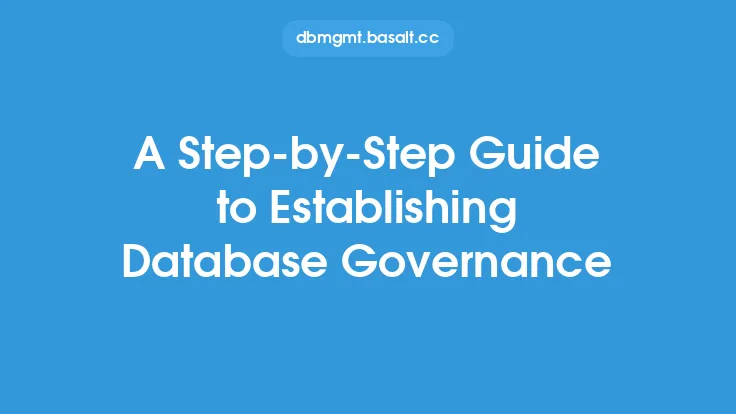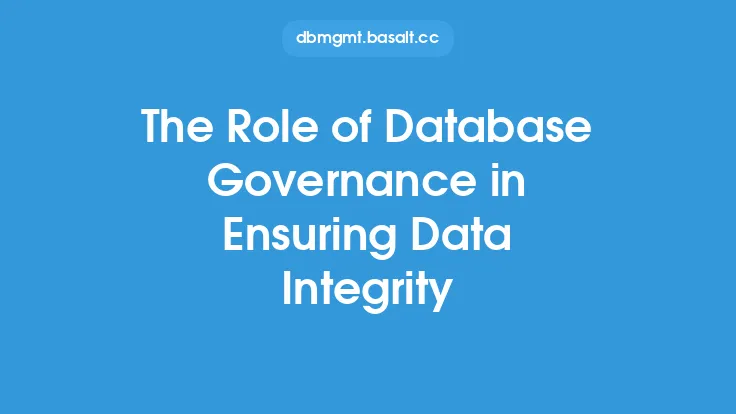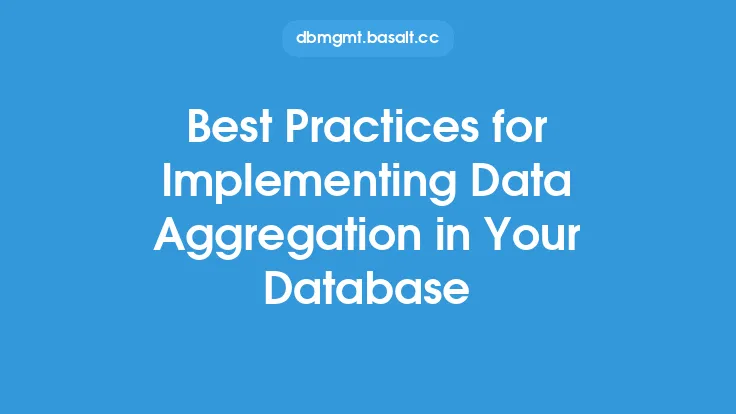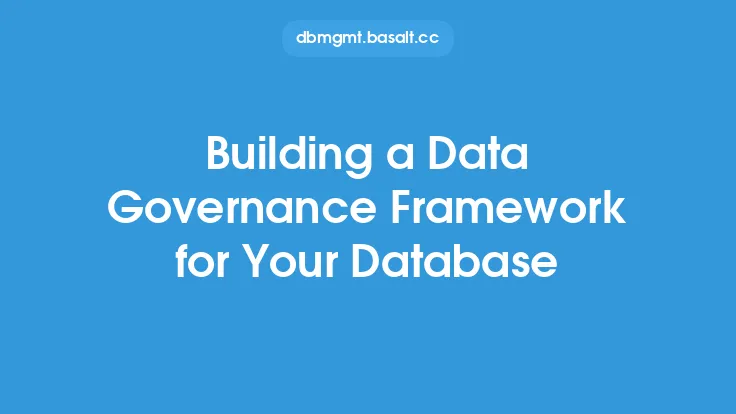Implementing effective database governance policies is a critical aspect of database administration, as it ensures the integrity, security, and reliability of an organization's data assets. Database governance refers to the set of policies, procedures, and standards that govern the management and use of data within an organization. Effective database governance policies provide a framework for managing data quality, security, and compliance, and help to ensure that data is accurate, complete, and accessible to authorized users.
Introduction to Database Governance Policies
Database governance policies are designed to promote data quality, security, and compliance, and to ensure that data is managed in a way that supports the organization's overall goals and objectives. These policies typically cover a range of topics, including data classification, data access and authorization, data backup and recovery, and data retention and disposal. Effective database governance policies should be based on industry best practices and should be tailored to the specific needs and requirements of the organization.
Key Components of Database Governance Policies
There are several key components of database governance policies that organizations should consider when developing their own policies. These include:
- Data classification: This involves categorizing data based on its sensitivity and importance, and applying appropriate security controls to protect it.
- Data access and authorization: This involves defining who has access to data, and under what circumstances, and ensuring that access is granted only to authorized users.
- Data backup and recovery: This involves ensuring that data is backed up regularly, and that it can be recovered quickly and easily in the event of a disaster or data loss.
- Data retention and disposal: This involves defining how long data should be retained, and how it should be disposed of when it is no longer needed.
- Data quality: This involves ensuring that data is accurate, complete, and consistent, and that it is free from errors and inconsistencies.
- Compliance: This involves ensuring that data is managed in compliance with relevant laws, regulations, and industry standards.
Implementing Database Governance Policies
Implementing database governance policies requires a structured approach that involves several key steps. These include:
- Defining the scope and objectives of the policy: This involves identifying the types of data that are covered by the policy, and the goals and objectives that the policy is intended to achieve.
- Conducting a risk assessment: This involves identifying potential risks and threats to data, and assessing the likelihood and potential impact of these risks.
- Developing policy statements: This involves creating clear and concise statements that outline the policies and procedures for managing data.
- Establishing procedures and standards: This involves defining the procedures and standards that will be used to implement the policy, and ensuring that these procedures and standards are consistent with industry best practices.
- Training and awareness: This involves providing training and awareness programs to ensure that users understand the policies and procedures, and know how to comply with them.
- Monitoring and enforcement: This involves monitoring compliance with the policy, and taking enforcement action when necessary to ensure that the policy is being followed.
Technical Considerations for Database Governance
From a technical perspective, implementing database governance policies requires a range of tools and technologies, including:
- Database management systems: These provide a range of features and functions for managing data, including data classification, access control, and backup and recovery.
- Data security tools: These provide a range of features and functions for protecting data, including encryption, firewalls, and intrusion detection systems.
- Data quality tools: These provide a range of features and functions for ensuring data quality, including data validation, data cleansing, and data transformation.
- Compliance tools: These provide a range of features and functions for ensuring compliance with relevant laws, regulations, and industry standards, including audit logging, reporting, and alerting.
- Data governance platforms: These provide a range of features and functions for managing data governance, including data discovery, data classification, and data lineage.
Best Practices for Database Governance
There are several best practices that organizations should follow when implementing database governance policies. These include:
- Establishing a data governance council: This involves bringing together stakeholders from across the organization to oversee data governance and ensure that policies are being followed.
- Developing a data governance framework: This involves creating a framework that outlines the policies, procedures, and standards for managing data.
- Conducting regular audits and assessments: This involves regularly reviewing and assessing data governance policies and procedures to ensure that they are effective and compliant with relevant laws and regulations.
- Providing training and awareness programs: This involves providing regular training and awareness programs to ensure that users understand the policies and procedures, and know how to comply with them.
- Continuously monitoring and improving: This involves continuously monitoring and improving data governance policies and procedures to ensure that they remain effective and relevant.
Common Challenges and Solutions
Implementing effective database governance policies can be challenging, and organizations may encounter a range of obstacles and issues. Some common challenges include:
- Lack of resources: This can make it difficult to implement and enforce data governance policies.
- Lack of awareness: This can make it difficult to ensure that users understand the policies and procedures, and know how to comply with them.
- Complexity: This can make it difficult to develop and implement effective data governance policies, particularly in large and complex organizations.
- Resistance to change: This can make it difficult to implement new policies and procedures, particularly if they require significant changes to existing practices and procedures.
- Solutions to these challenges include:
- Providing adequate resources and support: This can help to ensure that data governance policies are implemented and enforced effectively.
- Providing training and awareness programs: This can help to ensure that users understand the policies and procedures, and know how to comply with them.
- Simplifying policies and procedures: This can help to make it easier to develop and implement effective data governance policies, particularly in large and complex organizations.
- Communicating the benefits of change: This can help to build support for new policies and procedures, and reduce resistance to change.





